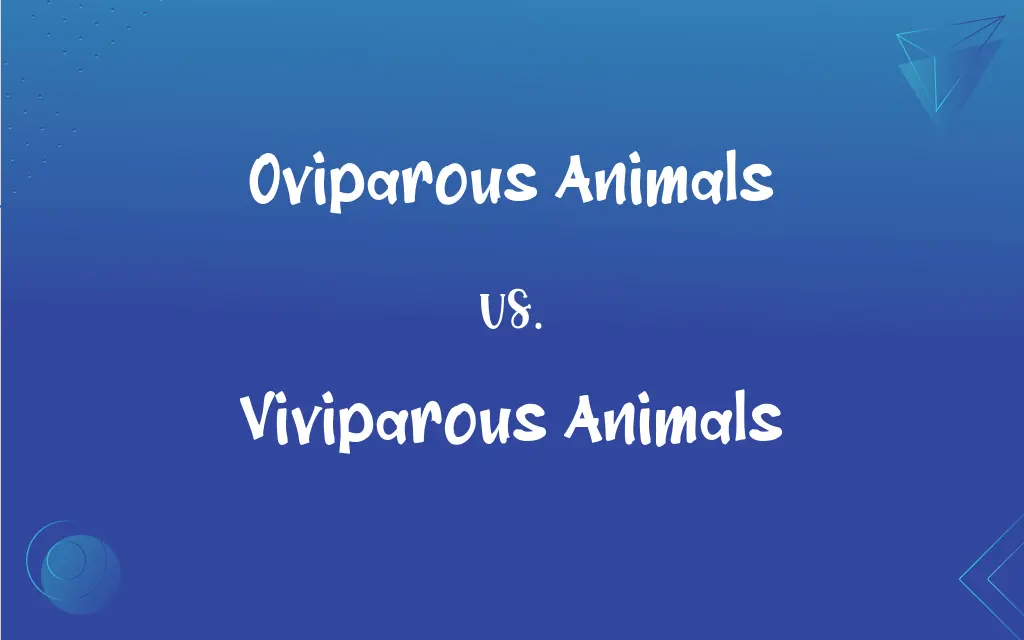Oviparous Animals vs. Viviparous Animals: What's the Difference?
Edited by Aimie Carlson || By Harlon Moss || Updated on October 4, 2023
Oviparous animals lay eggs that hatch externally, while viviparous animals give birth to live young.

Key Differences
Oviparous animals are creatures that reproduce by laying eggs, with the embryo developing outside the mother's body. Viviparous animals, on the other hand, give birth to live young, with the offspring developing internally, typically connected to the mother via a placenta.
For oviparous animals, the environment plays a critical role in the development of their eggs. These eggs often have protective shells, and the embryo within receives nutrients from the yolk. Viviparous animals' embryos, conversely, usually receive direct nourishment from the mother through specialized structures, ensuring a safer environment for growth.
Birds, most reptiles, and many fish are oviparous, laying eggs that are fertilized before being laid and then incubated. In contrast, most mammals, excluding the monotremes, are viviparous, with the fetus developing inside the mother until it's sufficiently matured to be born.
While oviparous reproduction often exposes the developing embryo to environmental risks, it allows for dispersal and colonization. Viviparous reproduction, meanwhile, requires more significant resources from the mother but often ensures higher survival rates for the young.
Comparison Chart
Method of Reproduction
Lay eggs that hatch externally
Give birth to live young
ADVERTISEMENT
Nutrient Source for Offspring
Yolk inside the egg
Direct nourishment from the mother
Example Species
Birds, most reptiles, some fish
Most mammals, some reptiles and fish
Environmental Exposure
Higher risk due to external development
Lower risk due to internal development
Embryonic Connection
No direct connection to the mother
Often connected via placenta or similar structure
Oviparous Animals and Viviparous Animals Definitions
Oviparous Animals
Creatures that lay eggs with external development.
Birds are a common example of oviparous animals.
ADVERTISEMENT
Viviparous Animals
Organisms with direct embryonic nourishment from the mother.
Elephants are viviparous animals, carrying their young for long gestation periods.
Oviparous Animals
Animals that reproduce by laying eggs in external environments.
Many fish species are oviparous animals.
Viviparous Animals
Animals that typically have placental connections during gestation.
Cats are viviparous animals, birthing multiple kittens.
Oviparous Animals
Animals that rely on yolk for embryonic nourishment.
Crocodiles are oviparous animals, laying eggs in nests.
Viviparous Animals
Species that don't lay eggs but birth live young.
Dolphins, as marine mammals, are viviparous animals.
Oviparous Animals
Organisms where offspring development occurs outside the mother.
Turtles are oviparous animals, laying their eggs on beaches.
Viviparous Animals
Creatures that give birth to live offspring.
Humans are viviparous animals.
Oviparous Animals
Species that utilize egg-laying as a reproductive method.
Most reptiles are oviparous animals.
Viviparous Animals
Animals wherein offspring develop internally before birth.
Whales are viviparous animals, nurturing their young internally.
FAQs
Which is more common among mammals: oviparous or viviparous reproduction?
Viviparous reproduction is more common among mammals.
Why might viviparous reproduction be advantageous?
It often ensures higher survival rates for the young due to protected development.
Are oviparous animals always cold-blooded?
No, while many oviparous animals are cold-blooded, birds are warm-blooded oviparous animals.
How do viviparous animals ensure the safety of their developing young?
Viviparous animals often have internal development and structures, like the uterus, to protect and nourish the young.
How do oviparous animals nourish their developing offspring?
Oviparous animals rely on the yolk inside the egg for nourishment.
What connects the fetus to the mother in many viviparous animals?
In many viviparous animals, the fetus is connected to the mother via a placenta.
What's the primary advantage of oviparous reproduction?
Oviparous reproduction can allow for dispersal and colonization.
Are there any viviparous fish?
Yes, some fish, like certain sharks, are viviparous.
Can oviparous animals provide any protection to their eggs?
Yes, many oviparous animals guard their nests or choose safe locations to lay their eggs.
What is the primary nutrient source for embryos in viviparous animals?
The primary source is direct nourishment from the mother, often via a placenta.
Do all viviparous animals have placentas?
No, not all viviparous animals have placentas, but many do.
How do fish species that are oviparous protect their eggs?
Some bury them, attach them to surfaces, or even carry them in special pouches.
Which type of reproduction, oviparous or viviparous, requires more resources from the mother?
Viviparous reproduction often requires more significant resources from the mother.
Do oviparous animals ever care for their young post-hatching?
Some oviparous animals, like certain birds, do care for their young post-hatching.
Is the gestation period in viviparous animals typically longer than the incubation period in oviparous animals?
It varies widely among species, but viviparous mammals often have longer gestation periods than the incubation times of many oviparous species.
Can the environment influence the sex of offspring in oviparous animals?
Yes, in some reptiles, the temperature during incubation can determine offspring sex.
Are there any reptiles that are viviparous?
Yes, some reptiles, like certain snakes and lizards, are viviparous.
Are all birds oviparous?
Yes, all birds are oviparous.
How does egg-laying in oviparous animals typically occur?
Oviparous animals lay fertilized eggs in various environments, depending on the species.
About Author
Written by
Harlon MossHarlon is a seasoned quality moderator and accomplished content writer for Difference Wiki. An alumnus of the prestigious University of California, he earned his degree in Computer Science. Leveraging his academic background, Harlon brings a meticulous and informed perspective to his work, ensuring content accuracy and excellence.
Edited by
Aimie CarlsonAimie Carlson, holding a master's degree in English literature, is a fervent English language enthusiast. She lends her writing talents to Difference Wiki, a prominent website that specializes in comparisons, offering readers insightful analyses that both captivate and inform.
































































